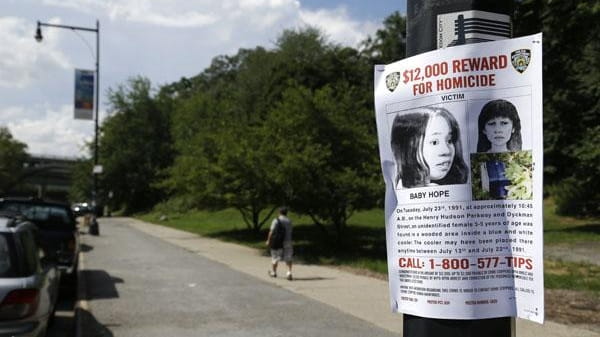Baby Hope's mother identified, NYPD confirms

On July 23, 2013, the 22nd anniversary of the discovery of the body of a young girl inside a cooler in Washington Heights, police offered a $12,000 reward for any information leading to an arrest and conviction in the unsolved crime. Officers put up posters in the neighborhood and handed out fliers with sketches of how the victim might have looked. Credit: AP/NYPD
A chance encounter between two women in a Washington Heights Laundromat sparked a fast-paced NYPD investigation that led to the stunning discovery of the identity of "Baby Hope," the child whose decomposed and abused body was found stuffed in a cooler near a Manhattan highway in 1991, a law enforcement official said Tuesday.
With luck, persistence and refined DNA techniques that emerged in the years after the Sept. 11, 2001, attacks, detectives were able to confirm the child's identity after finding her mother, a woman who police Commissioner Ray Kelly said Tuesday was cooperating with the homicide investigation but is not being publicly identified.
Kelly said the child's mother was found "through . . . outstanding detective work."
DNA was taken from Baby Hope's bones by city medical examiners after the child's body was exhumed from a cemetery in the Bronx in 2006, said a law enforcement source. The child was believed to be between 3 and 5 years of age, officials said at the time.
The latest developments in the case -- which had vexed investigators since Baby Hope's body was discovered sexually abused and bound, said the NYPD at the time -- were welcome news to retired NYPD homicide detective Jerry Giorgio. He worked the case from the time the body was found until he retired in 1997. Giorgio said he kept the case alive after he started working as an investigator with the Manhattan district attorney's office. "I am elated, to put it mildly" said Giorgio, 79. "I equate this to the birth of my children, my marriage."
Giorgio retired from the district attorney's office in July of this year, the month police started their annual canvassing of upper Manhattan, putting up posters of Baby Hope's police artist reconstruction sketches.
A rare break for detectives started not with the DNA match, but as a result of the women in the in the Laundromat five years ago, said the source, who asked not to be identified.
The two women were talking about the Baby Hope case when one of them blurted out "that was my sister," a remark the other woman initially discounted, the source said.
This summer, when the posters reappeared, the woman remembered the conversation and confided to a friend who implored her to call police, the source said. The woman called the NYPD, sparking an intense investigation that led detectives to the woman who claimed Baby Hope was her sister. Last week police used DNA to identify the child's mother, the source said.
The father, whose identity was not released by the NYPD, is believed to be alive and is being sought for questioning, the source said. The mother has indicated that Baby Hope was in the care of the father or another relative when she disappeared.
The mother had an alibi that placed her out of the country when the child disappeared, said another source familiar with the case.
The efforts by the NYPD had come up empty until DNA analysis similar to that used to identify victims of the Sept. 11, 2001, attacks found a match, the source said. Since the attacks, advances have been made that make it easier to get DNA from bone for analysis, something, said forensic expert Mitch Holland, that has been done with samples from Ground Zero.

Updated now Newsday travel writer Scott Vogel took the ferry over to Block Island for a weekend of fun.

Updated now Newsday travel writer Scott Vogel took the ferry over to Block Island for a weekend of fun.
